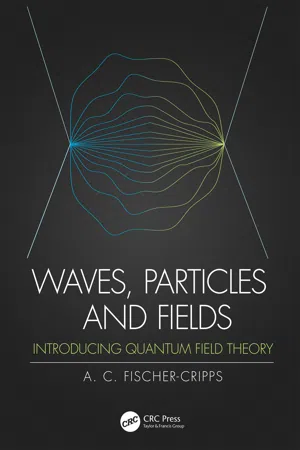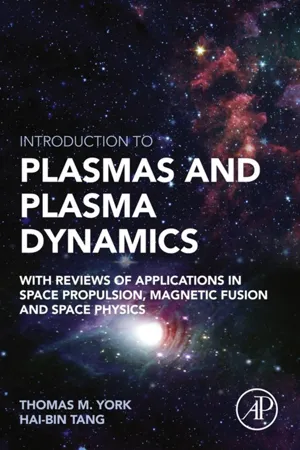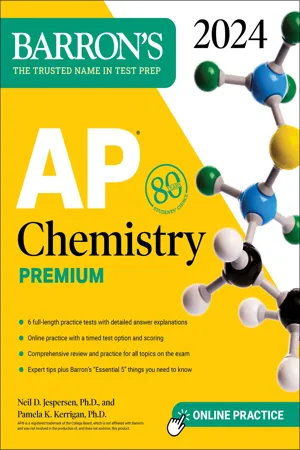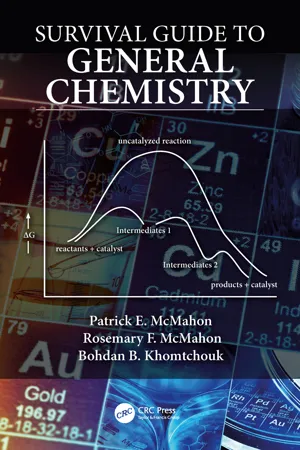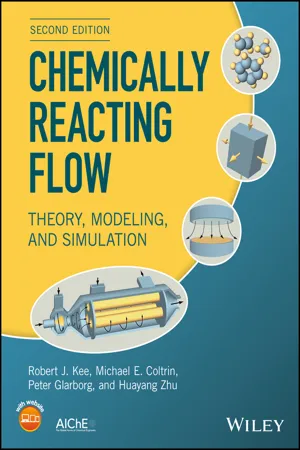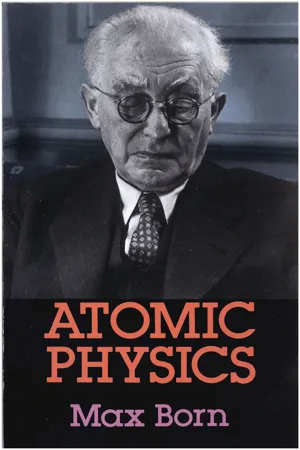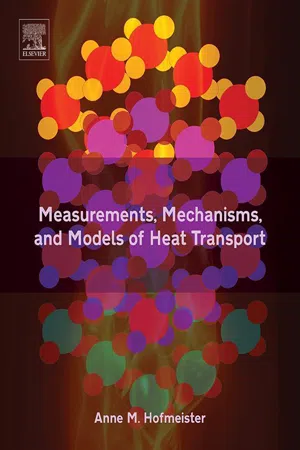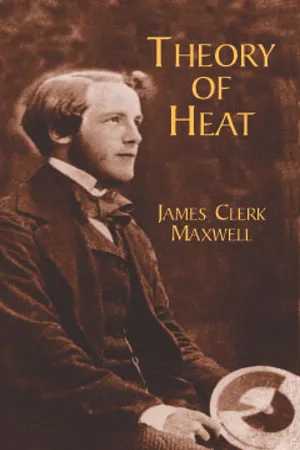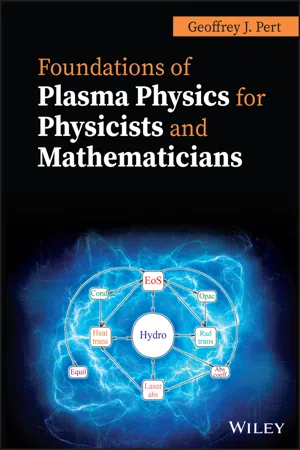Chemistry
Kinetic Molecular Theory
The Kinetic Molecular Theory explains the behavior of gases based on the motion of their particles. It states that gas particles are in constant, random motion and that their kinetic energy is directly proportional to their temperature. Additionally, the theory describes the relationship between pressure, volume, and temperature in ideal gases.
Written by Perlego with AI-assistance
Related key terms
Related key terms
1 of 4
Related key terms
1 of 3
11 Key excerpts on "Kinetic Molecular Theory"
- eBook - ePub
Waves, Particles and Fields
Introducing Quantum Field Theory
- Anthony C. Fischer-Cripps(Author)
- 2019(Publication Date)
- CRC Press(Publisher)
44.1 Introduction
Consider N molecules of an ideal gas inside a container of volume V at an absolute temperature T . We recognise that in normal circumstances, there are a great many molecules, too small to be seen individually, moving with great velocity and undergoing collisions with the walls of the container and each other. Indeed, in a typical macroscopic system, the number of gas molecules is of the order of Avogadro’s number, 6 × 1023 molecules – far too many to calculate the individual velocities and displacements. The average velocity of such molecules is of the order of 1000 m s−1 . The typical distance a gas molecule might move before colliding with another, or the container walls, is of the order of 100 μm – far greater than the size of the molecule itself. These figures set the scale of what we are about to study.Unlike the motion of planets in the solar system, of which there are only a few easily seen bodies, the study of gases cannot be done on an individual basis. As such, any macroscopic properties that are required to be measured in the laboratory, like pressure and temperature, can only be described in terms of the average motion of a large number of individual molecules making up the gas.The kinetic theory of gases uses the statistical average of individual motions to describe macroscopic quantities. In order to do this, several basic assumptions must be made to begin with:- The molecules are negligibly small in comparison to the size of the container and the distance between them.
- The molecules collide elastically with each other and the walls of the container.
- The molecules do not otherwise interact (e.g. no attractive forces between them – such as there would be in a solid or liquid).
- The molecules have an initial random motion.
Because there are such large numbers involved, statistical treatments lead to great certainty in the predictions of macroscopic quantities, and this is the power of statistical mechanics. Unlike classical thermodynamics, which deals with experimentally derived equations of state to describe the relationship between macroscopic properties of gases, statistical mechanics seeks to derive these macroscopic relationships from microscopic properties which, in some circumstances, involve the quantum aspects of matter. Since the analysis of single molecules in these circumstances is not feasible, we gain access to these microscopic quantities by considering the statistics of the properties of large numbers of individual molecules. - eBook - ePub
Introduction to Plasmas and Plasma Dynamics
With Reviews of Applications in Space Propulsion, Magnetic Fusion and Space Physics
- Hai-Bin Tang(Author)
- 2015(Publication Date)
- Academic Press(Publisher)
Chapter 2Kinetic Theory of Gases
Abstract
This chapter begins with a definition of idealized molecular behavior that incorporates classical momentum and energy conservation. The gas laws at standard conditions are derived and explained within this formalism. The transport phenomena of viscosity, conduction, and diffusion are similarly treated. Statistical concepts are introduced to establish a mathematical basis for deriving macroscopic properties. The velocity (Maxwellian) distribution function is derived from physical laws and with the introduction of entropy as an important descriptive variable of state. Average values of molecular speeds are derived. The extension of the ideal molecular model as the basis for describing real gases is discussed.Keywords
Equilibrium distribution function; Kinetic theory; Pressure; temperature, and energy relationships; Transport processes (viscosity, conduction, and diffusion)Introduction
In the study of the mechanics and energetics of fluid flow, normally the fluid is considered to be a continuous medium (continuum), describable by properties such as density, temperature, pressure, and viscosity. For example, energy is defined as C V T 0 . Since the basic problem is that of the interchange of a large amount of energy in and out and fluid systems, we must look at what a fluid is “in the small” (microscopically) as well as “in the large” (macroscopically) so that we can understand what energy “is” (what its forms are), and how it can change when added to or removed from a fluid. The energy exchange is central, and the effects of the energy exchange are secondary.Kinetic theory originated in an attempt to explain and correlate the familiar physical properties of gases on the basis of molecule behavior (perfect gas law as stated for imperfect gases, viscosity, conduction, and diffusion).Basic Hypotheses of Kinetic Theory
Basic Hypotheses (Present, 1958 )
1. Molecule hypothesis—“matter is composed of small discrete units known as molecules: that the molecule is the smallest quantity of substance that retains its chemical properties, that all molecules of a given substance are alike, and there are three states of matter which differ in the arrangement and state of motion of molecules.” - No longer available |Learn more
- Neil D. Jespersen, Pamela Kerrigan(Authors)
- 2023(Publication Date)
- Barrons Educational Services(Publisher)
Substituting these data gives The effective molar mass of air is approximated from the fact that air is 80 percent nitrogen and 20 percent oxygen: TIP This is similar to the calculation of the average atomic mass of an element. See page 119. We may also conclude that a balloon full of neon will rise in air, whereas an argon-filled balloon will sink to the floor. Kinetic Molecular Theory The ideal gas law describes the relationships among P, V, T, and n for ideal gases. The Kinetic Molecular Theory describes gases at the level of individual particles. This theory, developed largely by Boltzmann, Clausius, and Maxwell between 1850 and 1880, is often stated as five postulates: 1. Gases consist of molecules or atoms in continuous random motion. 2. Collisions between these molecules and/or atoms in a gas are elastic. 3. The volume occupied by the atoms and/or molecules in a gas is negligibly small. 4. The attractive or repulsive forces between the atoms and/or molecules in a gas are negligible. 5. The average kinetic energy of a molecule or an atom in a gas is directly proportional to the Kelvin temperature of the gas. The concept of gas pressure is important to understand since it is central to the Kinetic Molecular Theory. Pressure is defined in physics as the force exerted per unit area. The English units for pressure, pounds per square inch, are familiar. For gases, the force is generated by collisions of the gas particles with the container walls. Each collision has a certain force, which is related to the velocity of the gas particle. The total force is the sum of the forces of all the collisions occurring each second per unit area. Thus, the pressure is dependent on the velocity of the gas particles and the collision frequency. In turn, the collision frequency depends on the velocity of the gas particle and the distance to the container walls. Changing the temperature changes the force of the collisions as well as the frequency of collision - eBook - ePub
- Patrick E. McMahon, Rosemary McMahon, Bohdan Khomtchouk(Authors)
- 2019(Publication Date)
- CRC Press(Publisher)
20 Working with Gas LawsI KINETIC THEORY OF GASES Phases of a compound or element (solid, liquid, gas) are determined by the balance between the strength of intermolecular forces and the average kinetic energy of the molecules. The gas phase is characterized by very weak attractive forces during which the average kinetic energy of motion dominates the physical properties of gases. For a restricted set of conditions, analysis of a gas is characterized by assuming that attractive forces between individual gas molecules are zero and that the volume occupied by the physical size of the molecules is essentially zero as compared to the volume of empty space between the molecules. Under these conditions, the gas, termed an ideal gas, is analyzed through the average statistical behavior of rapidly moving independent particles.Gases have very low density as there is a relatively large amount of empty space between individual molecules. Gases can have variable volumes; they can expand (molecules become farther apart) or be compressed (molecules are squeezed closer together). The pressure of a gas is produced by the kinetic energy of molecular collisions on the walls of the container. Gases can diffuse into each other; the rapidly moving molecules of two distinct gases can occupy the empty spaces between each other and form a gas solution (mixing at the molecular level).The kinetic energy of a gas molecule (or atom) in units of Joules is found from kE = ½ mv2 where m = the molecular (or atomic) mass in kilograms and v = velocity of the molecule in meters per second. The average kinetic energy of any sample of a specific molecular gas is determined by the molecular mass and the average or mean velocity: kE(average) = ½ m(v(average) )2 ; v(average) ≅ v(mean) - eBook - ePub
- Michael M. Mansfield, Colm O'Sullivan(Authors)
- 2020(Publication Date)
- Wiley(Publisher)
12 Microscopic models of thermal systems: kinetic theory of matterAIMS
- to interpret thermodynamic behaviour in terms of microscopic models
- to explain how the temperature, the internal energy and the heat capacity of a gas may be understood from a microscopic perspective
- to describe how statistical distributions are used in the study of thermal systems (an introduction to statistical mechanics)
- to present a simple microscopic interpretation of the heat capacity of solids
12.1 Microscopic interpretation of temperature
In Chapter 10 we saw that the mechanical behaviour of gases at low pressure, essentially Boyle's law, could be explained by a microscopic model, called the kinetic theory of an ideal gas. In particular, we found (Equation (10.12) ), that the product PV could be written in terms of microscopic quantities as followswhere N is the number of molecules, each having a mass m, in the system and is the average kinetic energy per molecule. Comparing this with the equation of state of an ideal gas as given by Equation (11.14) ,we see that the theoretical treatment of the microscopic model predicts a relationship which has the same general form as the experimentally based equation of state which relates macroscopic quantities. Furthermore, a comparison of the two equations leads us to the conclusion that the macroscopic concept of temperature can be interpreted as a direct measure of the average kinetic energy of the molecules (a microscopic quantity). In other words, we now conclude that(12.1)where k is a constant called the Boltzmann constant (the factor of arises because the Boltzmann constant was originally introduced in a somewhat different context). Historically the value of the Boltzmann constant had to be measured experimentally (for example, see Worked Example 12.2); however, the revised definition of the kelvin (Section 11.2 ) now fixes its value at exactly - eBook - ePub
Chemically Reacting Flow
Theory, Modeling, and Simulation
- Robert J. Kee, Michael E. Coltrin, Peter Glarborg, Huayang Zhu(Authors)
- 2017(Publication Date)
- Wiley(Publisher)
[1, 2]. The theory assumes that molecules in a gas consist of rigid, hard spheres of mass m and diameter d in continuous, randomly directed translational motion. Collisions between molecules are assumed to be instantaneous, and the molecules travel in straight-line trajectories between collisions until randomly encountering another collision partner or colliding with a container wall. Molecule-wall collisions are also considered to be instantaneous and elastic ; that is, the molecule is assumed to lose no translational energy from the collision with the wall. In a three-dimensional container, each molecule can have three velocity components (v x, v y, and v z) and is said to have three degrees of freedom of motion; that is, one degree-of-freedom for each dimension in which it is free to move. Because the molecular motion is randomly distributed in direction (10.1) where v 2 is the total velocity squared (= v 2 x + v y 2 + v 2 z). So, the average kinetic energy of a given molecule is (10.2) The kinetic theory of gases is used to bridge the mechanical properties (in the sense of classical mechanics) that involve m and v to non-mechanical properties that are quantities like temperature and thermodynamic functions. This is done through the ideal gas law, in which the average energy on a per mole basis is (10.3) where R is the gas constant (R = 8.31446 J mol −1). Or, on a per molecule basis (10.4) where is Boltzmann's constant (k B = 1.38065 × 10 −23 J K −1) and is Avogadro's number (). Equating Eqs. 10.2 and 10.4, (10.5) or (10.6) where W is the molecular weight (kg mol −1). This yields a simple formula for the root-mean-square (rms) velocity of a gas (m s −1) (10.7) 10.2 Molecular Energy Levels To understand and to obtain estimates of molecular thermochemical properties of species to incorporate into chemically reacting flow simulations requires going far beyond the kinetic theory of gases that was just summarized - eBook - ePub
- Max Born(Author)
- 2013(Publication Date)
- Dover Publications(Publisher)
U denotes as before the mean kinetic energy of the translational motion of the molecules, per mole, but it is no longer the same as the total energy.4. Temperature of a Gas.From the kinetic theory of gases, without a knowledge of the law of distribution of velocities (i.e. of the way in which the number nv depends on v), we have found that the product of pressure and volume is a function only of the mean kinetic energy of the gas. But we have also an empirical law, the law of Boyle (1660) and Mariotte (1676), viz.: at constant temperature the product of the pressure and volume of an ideal gas is constant. We must conclude from this that U, the mean kinetic energy per mole, depends only on the temperature of the gas.In the kinetic theory of gases, the concept of temperature is primarily a foreign element, since in fact the individual molecules are characterized by their velocity alone. But it suggests itself that we should define the absolute gas-temperature T in terms of the mean kinetic energy. This is usually done in accordance with the equationwhere on the left we have the mean kinetic energy of a component of the motion of the centre of inertia of a molecule; k is called Boltzmann’s constant. For the total motion of the centre of inertia we have therefore alsoand, referred to a mole, where we putThe justification for this definition of temperature lies in the fact that when we introduce the last expression in the formula for the gas pressure deduced above, we obtain formally the relation which combines the laws of Boyle-Mariotte and of Gay-Lussac and Charles:R is called the absolute gas constant, and can easily be calculated from measurements of three corresponding values of p, V, and T - Anne M. Hofmeister(Author)
- 2018(Publication Date)
- Elsevier(Publisher)
Circles in various colors: atoms. Black arrows: direction of physical motion of atoms or molecules. White arrows: vibrations of atomic bonds. (A) Ideal gas, where large distances exist between atoms, so that interactions are limited to brief collisions and diffusion of mass is entirely kinetic and fully coupled to heat transfer. Motions occur even in the in the absence of organized flow. This depiction is a first approximation to real, monatomic gases. (B) Pourable liquid, where molecules are close together but motions are somewhat impeded by neighboring molecules. For simple molecules, energy exchanges are mostly kinetic, occurring via collisions, but due to proximity of molecules, energy of vibrations can be somewhat exchanged between molecules. As liquid density and the size (and complexity) of individual molecules increase, motions become more hampered and vibrations become increasingly important to the transfer of energy. (C) Ball-and-stick depiction of a crystalline solid, specifically SiO 2 with the keatite structure, taken from Creative Commons. Interatomic bonds (sticks) link constituent atoms (balls) in all directions, which severely limits motions. Vibrations are limited by symmetry. Atoms can diffuse towards defects: otherwise bonds must be broken and reformed to move atoms. Along this vein, Eq. (5.3) was derived assuming point masses. An immediate problem, recognized historically, was that point masses cannot collide. The model morphed to consider collisions of hard spheres. Below, we show that the formulation for viscosity in the kinetic theory of gas is incomplete, because deformable spheres of finite size will not only collide, but they will also rub while passing (Fig- eBook - ePub
- (Author)
- 2012(Publication Date)
- Dover Publications(Publisher)
If we determine the motion of the centre of gravity of all the molecules within a very small region surrounding a point in a gas, then the velocity of the gas within that region is defined as the velocity of the.centre of gravity of all the mole. cules within that region.This is what is meant by the motion of a gas in common language. Besides this motion, there are two other kinds of motion considered in the kinetic theory of gases. The first is the motion of agitation of the molecules. This is the hitherto invisible motion of the molecule considered as a whole. Its course consists of broken portions, called free paths, interrupted by the encounters between different molecules.The second is the internal motion of each molecule, consisting partly of rotation and partly of vibrations among the component parts of the molecule.The velocity of the centre of gravity of a molecule is the resultant of the velocity of the gas and the velocity of agitation of the individual molecule at the given instant. The velocity of a constituent part of a molecule is the resultant of the velocity of its centre of gravity and the velocity of the constituent part relatively to the centre of gravity of the molecule.THEORY OF THE PRESSURE OF A GAS.
Let us consider two portions of a gas separated by a plane surface which moves with the same velocity as the gas. We have seen that in this case the number of molecules which pass through the plane in opposite directions is the same.Each molecule in crossing the plane from the region A to the region B enters the second region in precisely the same state as it leaves the first. It therefore carries over into the region B, not only its mass, but its momentum and its kinetic energy. Hence, if we consider the quantity of momentum in a given direction existing at any instant in the particles in the region B, this quantity will be altered whenever a molecule crosses the boundary, carrying its momentum along with it.FIG. 41.Now let us consider all the molecules whose velocity differs by less than a certain quantity, c , from a given velocity the components of which are u in the direction perpendicular to the plane from A towards B, and v and w - Geoffrey J. Pert(Author)
- 2021(Publication Date)
- Wiley(Publisher)
4 Kinetic Theory of Gases4.1 Introduction
The foundation of the theory of many particle systems is kinetic theory. Although the single particle theory of charged particle motion is sufficient when inter‐particle interactions can be neglected, it is clearly inadequate to handle the behaviour when the particles interact amongst themselves. In a plasma, the dominant interactions are between charged particles via the long‐range Coulomb force. This behaviour is in contrast to gases, where short‐range forces, for example van der Waals forces, between the molecules, are important. As we shall see this leads to major differences in the kinetic behaviour of plasmas and gases. Nonetheless, it is easier to develop kinetic theory in terms of systems interacting via short‐range forces and generalise to include plasmas later. Initially, we will examine the fundamentals of kinetic theory in terms of a dilute gas of single species of identical molecules interacting via short‐range forces.Kinetic theory develops the behaviour of a system of interacting particles via their statistical properties. In view of the very large number of particles in a laboratory volume, it would be impracticable to follow the dynamics of individual particles in time – although such calculations form the basis of molecular dynamics simulation. Individual particle motions are defined by Hamilton's equations, and as a consequence the particle trajectories are reversible, i.e. if we reverse the direction of time and the velocities, the particles retrace their paths, as for the single particle model. The system is therefore thermodynamically reversible. However, we know from classical thermodynamics that gas systems are subject to dissipation from diffusion, viscosity, and thermal conduction, and in consequence irreversible. If we take into account the statistical nature and exceptionally large number of particles, it becomes apparent that only after exceedingly long times can the system return to its original state. In general, over practicable observation times, the system tends to its state of maximum probability, maximum entropy consistent with the second law of thermodynamics. In most cases, this is the Maxwell–Boltzmann velocity distribution from which only infinitesimally small fluctuations are found.- eBook - ePub
- Leo Graetz, G. Barr(Authors)
- 2014(Publication Date)
- Routledge(Publisher)
Kinetic Theory of Gases . A body may exist either in the solid, liquid, or gaseous state. It is obvious that the molecules of solid and liquid bodies must be much closer together, that they must fill space much more completely than they do in the gaseous state. For the observed density or specific gravity of a body, i.e. the ratio of the mass of a body to its volume, is much greater in the solid and liquid states than in the gaseous. Since the molecules in the gaseous state are, on the average, at relatively great distances from one another we may further assume, as the Kinetic Theory of Gases does, that the forces which, in general, exist between molecules and which decrease in magnitude with increasing separation of the molecules, become vanishingly small for substances in the gaseous state.According to this theory the properties of gases depend on the fact that the individual molecules of a gas are not at rest but in lively motion. Now since the forces between the molecules disappear on account of the relatively great separation, that is, there is no force acting on a molecule, its motion can only be in a straight line with constant velocity. Every molecule, then, travels about in straight lines. Since there are a large number of molecules even in a small space, the molecule must soon collide with another. In this proximity to a second molecule, molecular forces will be operative. Their effect may be interpreted as being that a molecule which meets another, collides with, and rebounds from it, like a billiard ball which strikes another. The same occurs when a molecule hits the wall of the vessel. We must, therefore, conceive of a gas as consisting of an enormous number of molecules which continually dart about in confusion and are always colliding with other molecules, and consequently changing the direction and magnitude of their velocity: between any two collisions each molecule moves in a straight line with constant velocity. Every individual molecule thus describes a zig-zag path, consisting simply of straight sections of greater or less length.
Index pages curate the most relevant extracts from our library of academic textbooks. They’ve been created using an in-house natural language model (NLM), each adding context and meaning to key research topics.
Explore more topic indexes
Explore more topic indexes
1 of 6
Explore more topic indexes
1 of 4
